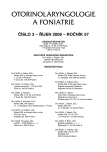Extraesophageal Reflux (Part 1) Epidemiology, Pathophysiology and Diagnostics
Authors:
Karol Zeleník 1
; Pavel Komínek 1
; I. Stárek 2; E. Machytka 3
Authors‘ workplace:
Otorinolaryngologická klinika FN, Ostrava
; přednosta doc. MUDr. P. Komínek, PhD., MBA
Otorinolaryngologická klinika LF UP a FN, Olomouc
1; přednosta prof. MUDr. I. Stárek, CSc.
Interní klinika FN, Ostrava
2; přednosta doc. MUDr. A. Martínek, CSc.
3
Published in:
Otorinolaryngol Foniatr, 57, 2008, No. 3, pp. 143-150.
Category:
Comprehensive Reports
Overview
Extraesophageal reflux refers to reflux of the (duodeno)gastric content that reaches structures superior to the level of the upper esophageal sphincter. It has been implicated in the pathogenesis of several otolaryngological disorders, including posterior laryngitis, vocal folds nodules, paroxysmal laryngospasm, Reinke’s edema, vocal fold ulcers and granuloma, globus pharyngeus, subglottic and laryngotracheal stenosis. Moreover, recent investigations indicate, that it can play a role in chronic rhinosinusitis, chronic ear complaints, snoring and laryngopharyngeal carcinoma. Because of nonexisting simple and effective diagnostic instrument, cause-and-effect relationship is far from proven. The review sumarizes this controversial topic emphasizing recent investigation results regarding pathogenesis and diagnostic procedures. In spite of the lack of consensus concerning interpetation criteria, 24hour pH-metry still remains the gold diagnostic tool.
Key words:
gastroesophageal reflux, extraesophageal reflux, otolaryngologic manifestation, pathophysiology, diagnostics.
Labels
Audiology Paediatric ENT ENT (Otorhinolaryngology)Article was published in
Otorhinolaryngology and Phoniatrics

2008 Issue 3
Most read in this issue
- Extraesophageal Reflux (Part 2) ORL Manifestation and Therapy
- Middle Ear Inflammation on the Basis of Chronic Purulent Middle Ear Inflammation with Cholesteatoma
- Extraesophageal Reflux (Part 1) Epidemiology, Pathophysiology and Diagnostics
- Auditory Neuropathy
